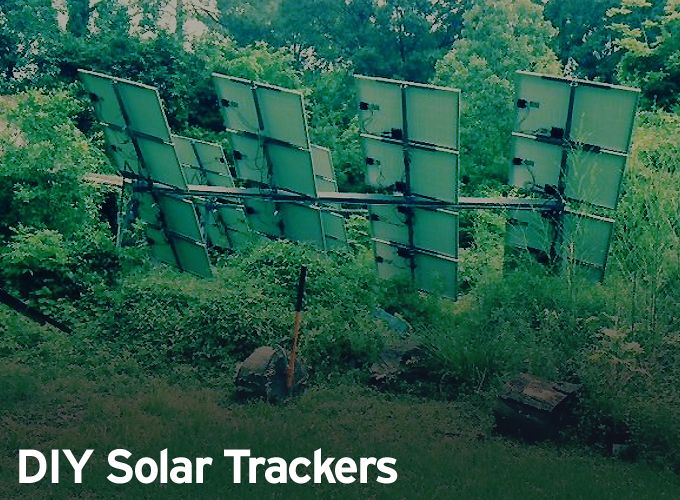The system incorporates panels and micro-inverters and steel and bearings and a microcontroller with an LCD display, to control the daily motion of the array. And, I might add, a light sensor to sense night time and daytime, and an AC current sensor to measure the amps produced (by the array) and amps consumed by the controller.
Bill Swann | Watt-Tracker
My name is Bill Swann, and I am a semi-retired machine designer. I decided that a good project would be to design some solar tracking array mounts. I soon discovered a handful of issues that a homeowner might face. One is shading if you live in a wooded area – I had to cut down 3 large trees to let in the sunlight. Another issue in some jurisdictions is wind loading. In Houston, a professional engineer is hired to verify that the array is attached securely for hurricane wind loads. By far, the largest issue is the installed cost per watt. Additionally, the fact that there are moving parts might be deterrence for the non-technical user. Also, who do you call if it stops working? What if a voltage spike fry’s the electronics? These are real what-if issues.
The array’s pictured above, are 2 axis trackers of the type “tilt – tip”. The horizontal bar rotates E to W to follow the daily motion of the sun. Additionally, the panels rotate on their individual spars to adjust for the seasonal variation in the sun’s elevation.
A good summary of the math to calculate the suns position is here, Chapter 3 and 4: http://powerfromthesun.net/Book/chapter03/chapter03.html
The system incorporates panels and micro-inverters and steel and bearings and a microcontroller with an LCD display, to control the daily motion of the array. And, I might add, a light sensor to sense night time and daytime, and an AC current sensor to measure the amps produced (by the array) and amps consumed by the controller. Since I am using micro-inverters, the watt hours ($) can be calculated. The system is totally autonomous. However, occasionally I have to manually jog the rotation, as the motion control is open loop. This could be remedied by using a $5 angle sensor with the C code. For those of you not familiar with C code, it is a programming language imbedded in the micro-controllers. High schoolers are being taught this today. Things have changed since slide rules! I’m dating myself.
Lesson #1: In the case of non-focusing solar panel trackers, the pointing accuracy is very loose. That is, if the panels are 20 degrees off from facing the sun, then the energy harvested is cosine(20) = 0.94%. That is, the energy harvested is 6% less than optimal. Compare to an error of 75 degrees – as would be found on a rooftop array in the late afternoon. Cosine (75) = 0.26%
A good estimate for the energy harvested is an application at the NREL website called PVWATTS. http://pvwatts.nrel.gov/. At this website, one can ask “what if I have a static array, or a single axis of motion array, or a double axis of motion array”. For Houston the gain is 23% for single axis motion over a fixed array.
The following photos are of a single axis tracker. It is 700 watts of panels, but could easily be 1200 watts with larger panels.
Lesson #2: Cost per watt. For the array pictured above, I have endeavored to minimize the fabrication cost and complexity. The actuator motor is 8 watts, and is turned on for 15 seconds every 20 minutes. The reason such a small motor is strong enough is that the main spar is mounted in bearings. I literally made 2 bearings by turning a bearing race in the bore of a 6” pipe section. And I dropped in 30 each of a stainless steel ball from McMaster-Car.
Lesson #3: Control of the daily motion. Keeping the array pointed toward the sun was accomplished by moving the array rain or shine. At night time, the array is positioned horizontally, to minimize wind loading. The control algorithm splits a 24 hour period into daytime or night time.
Night time Algorithm: During night time, the goal is to determine the night length, by using a light sensor. At first light in the morning, the accumulated night minutes is divided by 2, and a correction factor is applied to account for the difference between first light and sunrise. For example if the accumulated night time minutes is 780 minutes, then the time at twilight is set as 780/2 + 30 = 420 minutes = 7:00 AM.
Day time Algorithm: The day time is divided into hours when tracking occurs, and before and after tracking. When tracking starts at 8 AM, the motion is 40 degrees to the east, then dwell for 78 minutes, then a 10 degree motion every 60 minutes to 4 PM, then dwell for 78 minutes, then return to horizontal. The move times and distances are settable in the code.
Electronics hardware: The junction box has an Arduino clone, an LCD, and a 2 relay board. One relay sets the actuator motor direction, and the other puts 110 volt to the motor. Additionally, there is a light sensor, a current sensor, and a wall wart to provide 12 volt power.
And by the way, in mid-April, 2015, I had a good day, harvesting 36.6 kwatt - hours of energy with 7000 watts of tracking PV. That compares accurately with PVWATTS for a 2 axis tracker.
Some mechanical design drawings are here. Warning – this is an engineering project. Some welding and machining is required.
The content & opinions in this article are the author’s and do not necessarily represent the views of AltEnergyMag
Comments (0)
This post does not have any comments. Be the first to leave a comment below.
Featured Product


